What’s that? This is the summer when you visit every NASCAR track and Elvis memorial in Dixie? Forget it.
Your passports are ready so you can take the kids to Six Flags over Cambodia? Put ’em away.
There’s a family reunion in Wisconsin and you promised to bring the cheese curds and bratwurst? Let the old folks starve.
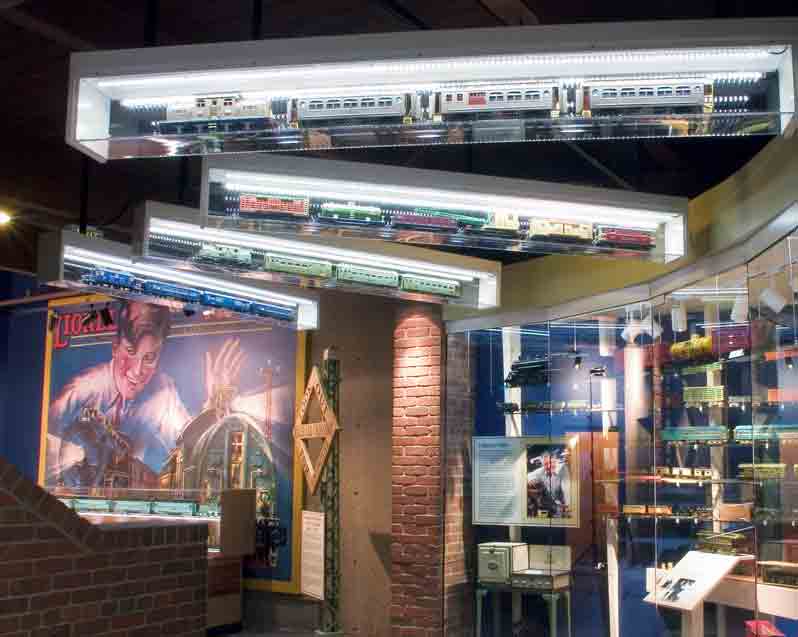
Instead, toss your vest with the railroad patches in a duffel bag and start thumbing in the direction of Sacramento. Tell the dude who stops that you need a lift to Old Sacramento State Historic Park, specifically, the California State Railroad Museum. That’s where you’ll find what’s being heralded as the greatest public display of American and European toy trains in North America.
Paradise at the top of the stairs
Once you arrive at the museum, “stop, look, and listen” to see which retired locomotives are operating on the nearby tracks. Then pay the admission fee and spend a few minutes on the first floor admiring the world-class collection of full-sized steamers and rolling stock.
Don’t miss the passenger car where Ronald Reagan dined while serving as governor of California. He was so taken by the museum’s equipment that he signed legislation that has, over the past 30 years, helped this institution grow until it has gained national significance.
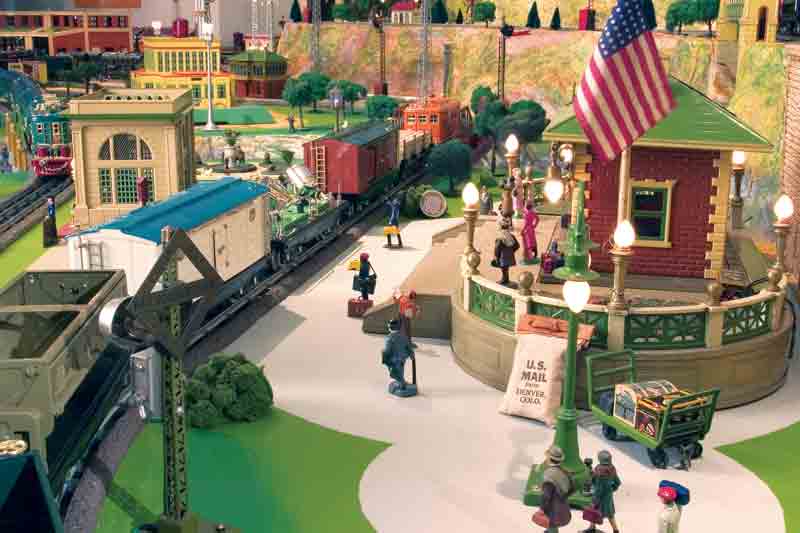
Other show stoppers downstairs include a streamliner that once be-longed to the Great Northern’s famed Empire Builder train. Everyone spends time gawking at and climbing into the cab of the only Southern Pacific Cab-Forward to escape the scrapper’s torch.
Now head to the second floor. Greeting you at the top of the stairs is art that expresses the rapture kids have always felt about toy trains. You’re gazing at a blown-up version of the illustration on the cover of the 1929 Lionel catalog. There, a boy marvels at two Standard gauge sets.
Beneath the image a display case sits atop a larger-than-life re-creation of a Lionel box from the 1920s. Inside that clear case are a Standard gauge steam freight outfit and the early version of the classic Transcontinental Limited (known as the “Green State set”), both of which appear in the illustration from 1929.
Accompanying text welcomes you to the 3,300-square-foot exhibit and describes what you are about to see. Walking through areas named “Toy Trains 101” and “Lionel City” will teach you about the history of toy and scale model trains from the late 19th century through the middle of the 20th century.
The final area, known as “Toy Trains for Everyone,” carries the story from World War II to the present. You can learn about the various sizes of miniature trains and get insights into how to join the throngs involved with what they laud as the “world’s greatest hobby.”
Of course, there’s no need to move too quickly. Linger through each section, especially those boasting interactive displays. One of these neat “extras” invites you to push buttons to learn how an electric train works. Another display features the realistic whistle that, after years of struggle, Lionel developed for its steam locomotives in the mid-1930s.
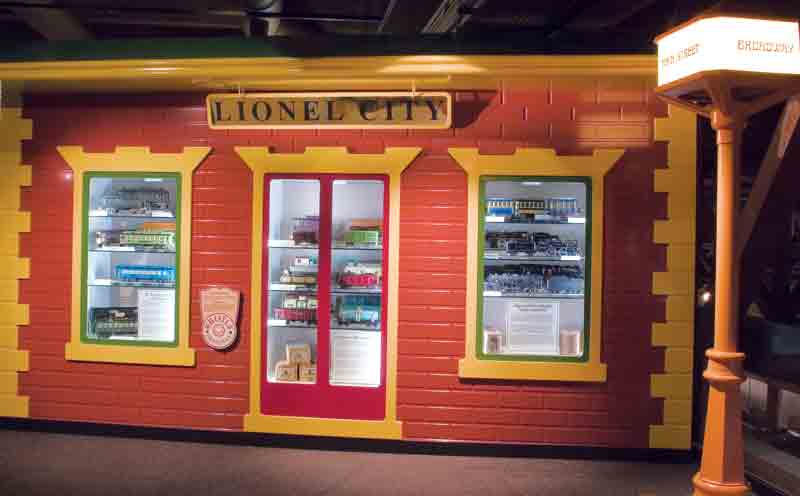
The sounds associated with these interactives prove to be as enjoyable and informative as the sights. Turning a dial on another display activates recorded radio and television announcements and advertising for toy trains. Elsewhere, you can hear the familiar record used with the A.C. Gilbert Co.’s talking station.
The highlight of the exhibit is a huge Standard and O gauge layout that occupies almost 600 square feet. Four trains can run at once. They pass by vintage Lionel stations and over bridges in scenes populated by landscaped plots and American- and British-made figures from the pre-World War I period.
Before arriving at the layout or encountering the timeline of toy trains, you’ll stroll through an oddly decorated section. It greets you as soon as you turn from the gallery’s introductory area.
Look up and you’ll see five Plexiglas cases suspended from the ceiling. Each of them holds a colorful Lionel, Ives, or American Flyer train from the 1920s.
Lower your gaze and you’ll notice an enormous showcase. Inside, boxes of Wide gauge trains share space with Buddy “L” riding equipment. Letters typed on Lionel stationery touch yellowing photographs. Placed amid these mementos are antique die-cast metal and wood playthings, including a Lionel electric stove sold in the early 1930s.
The jumble of items may confuse you until you read the placards. They explain that this section is supposed to leave you feeling that you’re standing in an attic crammed from floor to ceiling with toys. The reason for designing such a scene (designated “Collector’s Attic”) relates to the man whose trains and legacy are paid tribute in this exhibit.
A gift to the people
A lifetime of searching for toy trains yielded an extraordinary collection that Thomas W. Sefton enjoyed showing to visitors. They followed him into the attic of his home and stood absolutely speechless at seeing locomotives and cars on shelves from the floor to the ceiling.
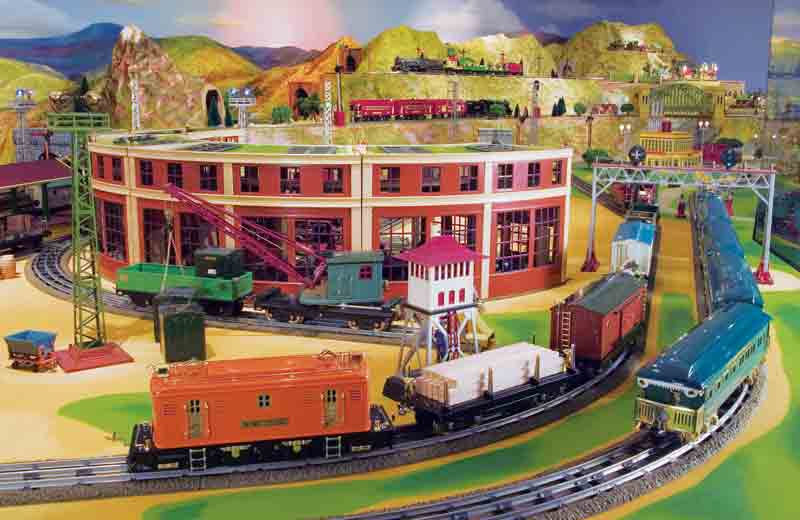
Standard gauge track snaked through the attic, and Sefton never hesitated to operate his prewar sets. Some of the finest trains made by Lionel and its rivals, American Flyer and Ives, ran by stations and through hand-painted tunnels.
As Sefton aged and his family considered what to do with his diverse collection of toy trains, the notion that they should be shared with the public took hold. A sense of stewardship had long guided this retired banker, and he had touched life in California in many ways.
Donating the trains to as esteemed an institution as the California State Railroad Museum seemed to be the perfect way to introduce people to their beauty and innovation. Curators there would display and operate landmark models. Crowds of tourists and students on field trips would discover the joys of Sefton’s hobby and perhaps adopt it themselves.
Members of the Sefton family and their lawyers finalized the details of the gift with Catherine Taylor and Stephen Drew, who head the museum’s experienced staff. Everyone realized that this donation represented a turning point for the museum. It would alter the identity of an institution connected with the history of prototype railroading.
On receiving the Sefton collection, the California State Railroad Museum found itself praised as a place where visitors can see trains of all sizes and learn how they have affected Americans. Toys and scale models have influenced lives as surely as the full-sized trains that have carried freight, moved people, and brought information for almost two centuries.
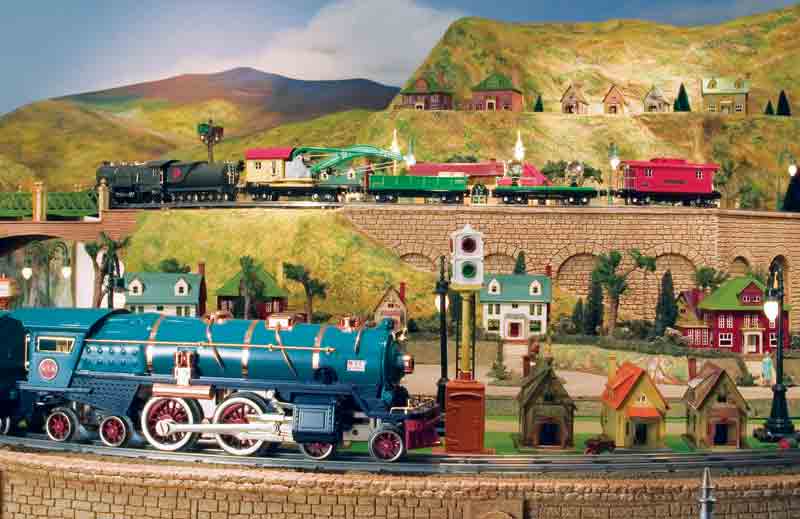
In 2002, trucks arrived at a warehouse rented by the museum to deliver Sefton’s hoard of American and European trains and accessories, along with the hundreds of Buddy “L” vehicles he had accumulated. When the last driver pulled away, Bruce Stiny, named curator of toy trains and scale models, had possession of more than 1,600 cartons.
Bruce and his colleagues knew the difficult – and thrilling – part of the project was about to begin. Their wish list was long. Bruce recalls that Cathy, Stephen, Pete Scott, and he imagined trains on shelves and in operation. They dreamed of interactive displays. A toy train paradise would arise in the second-floor areas set aside for the Sefton exhibit.
Path-breaking displays
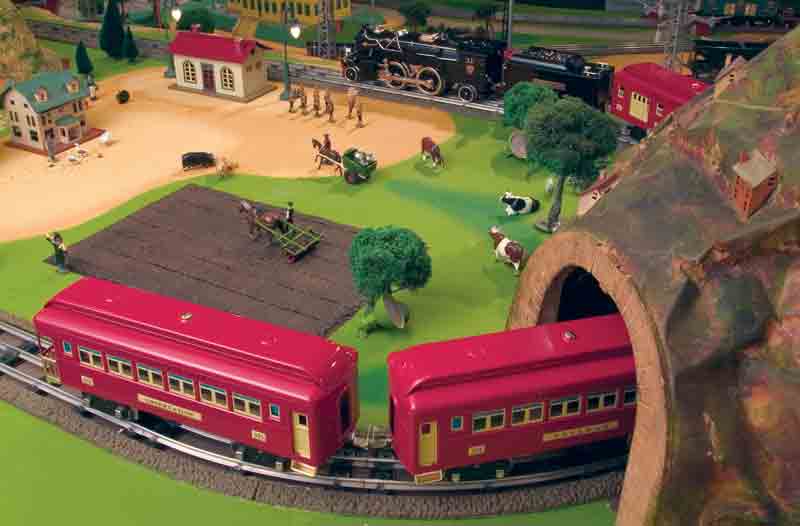
Much of what is on display fulfills the plans that the museum’s curators had in mind from the start. They knew that Sefton’s collection had extraordinary breadth. Bruce and Jack Ahearn, a toy train enthusiast and museum volunteer, confirmed that fact as they removed the items wrapped inside each box. “The trains, buildings, figures, vehicles, and more that had been given to us covered the period from the late 19th century to the middle of the 20th,” Bruce states.
Consequently, viewers are able, through a three-dimensional timeline, to observe how miniature trains evolved during that span of years. Adults like slowing down to examine the cast-iron floor toys and wood locomotives that children pulled before power sources were added. Then they observe examples of locomotives that relied on alcohol-burning or hand-wound “clockwork” mechanical engines to move.
The museum obtained from Sefton a Carlisle & Finch mining train and a handful of Lionel’s earliest electrically powered 2 7/8-inch gauge models (notably, a pair from 1902). All of these rare items add depth to the timeline.
Ives, the chief manufacturer of toy trains at the turn of the 20th century, intrigued Sefton, and he searched for examples of that firm’s Wide and O gauge production. No surprise that Ives pieces occupy a prominent place in the exhibit.
Also from the first two decades of the previous century is a selection of models and power sources made by Voltamp, a firm in Baltimore. The size and excellence of this scarce group further distinguish Sefton’s collection, as Voltamp is judged as having made the finest toy trains in the United States in that era.

The timeline continues with Lionel emerging as the dominant player in the field after World War I. Standard gauge electric-profile locomotives and early rolling stock give way to the handsome, detailed models associated with the “classic era” (lasting from the mid-1920s well into the Great Depression). Evident, too, is the development of Lionel’s O gauge line, trains that eventually superseded their larger, heftier cousins.
But, speaking candidly, shelves packed with models that show how toy trains changed wouldn’t hold the attention of youngsters or tourists unfamiliar with the hobby. Bruce, Stephen, and Pete knew from the get-go that the exhibit needed action and animation if they hoped to keep visitors there and drive them to return.
The Sefton family agreed, which explains why it increased its gift to include funds to underwrite the design of an exhibit unlike any other. The search for the right firm to handle this critical part led across the country to a suburb of Detroit and a group of creative, highly motivated artists and administrators eager to land this assignment.
Exhibit Works, though established only in 1979, had made a name as one of the leading designers of displays at automotive trade shows and public science and historical institutions. Toy trains were not in its repertoire, yet Allison Monan and Jim Notariani, who handle the day-to-day operations of the firm’s museum services division, were eager to add them. They believed the Sefton collection afforded the ideal opportunity.
Exhibit Works, assisted by two experts in the toy train field [Charles Leibrock, formerly of Lionel Trains Inc., and CLASSIC TOY TRAINS’ very own senior editor, Roger Carp – Editor], put forth an ambitious plan to transform a section of the museum’s uppermost level. This elongated area was, Cathy and Stephen said flatly, the only space in the building available for the Sefton Gallery.
This 150-foot-long section was not empty. For the previous 15 years, an exhibit and small layout created by the Toy Train Operating Society had filled it. The challenge facing the team from Exhibit Works was how to give new life to this compact area while making the best use of the tiny fraction of the Sefton collection that could be fit in.
Allison and Jim also needed to accommodate the museum’s wish to carry the toy train saga to the present. Although Sefton owned few models from the post-World War II decades, Stephen and Pete wanted the exhibit to shed light on how the toy and scale model hobbies had grown over the past 50 years. To accomplish this goal, they preferred to use O and HO scale trains previously donated to the museum, along with a few live-steam locomotives recently purchased.
In the weeks prior to winning the contract and in the months that followed, Kevin Patten, the museum designer at Exhibit Works, put in long hours at his drawing board and computer screen. He studied prewar trains to understand the best ways of showcasing them to help the public appreciate their beauty and detail.
Next came sketch after sketch, proposal after proposal. Kevin consulted with the late Donald Fee, who had helped found Exhibit Works, on his ideas for placing “relics” on illuminated shelves that would be installed within gigantic displays based on Standard gauge accessories.
One such display would resemble a Lionel No. 155 freight platform; another was going to be modeled after a No. 134 station. The cases in each display needed to be illuminated with light-emitting diodes and have their own air-conditioning unit and humidity control. Next to the displays would stand overgrown versions of prewar Lionel warning signs and street lamps.
Windows on one side of the Lionel-ville station feature steam locomotives from the 1910s and ’20s, in addition to the largest of Standard gauge passenger cars cataloged a few years later. Coaches from the Blue Comet and State sets show off their amazing detail, right down to the seats, tables, and washrooms inside.
Step around the corner and you’ll see how the opposite side of the station in Lionel City has been used to bring the toy train story into the 1930s. Besides a few Lionel streamlined trains, there are models marketed by two of its rivals at the time, American Flyer and Dorfan.
Kevin thought an enormous version of a Lionel passenger car might also amuse and impress visitors. Therefore, before reaching the center of the gallery, people turn from the showcases bordering the open area overlooking the first floor and encounter a display based on a car from the Green State set.
Reigning inside the coach’s windows are trains praised as the greatest made in Europe and America in the 1930s. At one end, Märklin is represented by an array of No. 1 and O gauge rolling stock and a “Krokodil” locomotive. Sefton always appreciated the fine craftsmanship that characterize these German trains, along with the stations, crossing gates, signals, and figures also in the Märklin line.
Facing these classics at the opposite end of the display is one of the true gems in Sefton’s collection. Stretched out to its full length is the later version of Lionel’s Transcontinental Limited, painted in two tones of brown. It comes with all its component packaging and the outfit box.
“I can stand in front of the Märklin and Lionel display for hours,” Bruce Stiny told me. “Seeing a Brown State set and the early version of the Blue Comet outfit behind it are almost as pleasing to me as fishing for trout up in Oregon.”
Prewar trains in action
“There must be an operating layout,” Pete and Stephen insisted from the beginning. “Visitors need to see trains running. That way, people will linger in the exhibit, talk about returning, and tell their friends that it’s worth seeing.”
No one disagreed. Still, the odd shape of the area available, plus the demands of climate control, accessibility for disabled viewers, and security requirements created nightmares for Exhibit Works as it planned the layout.
Kevin turned to Bruce and Chuck Leibrock for advice on how to design a track plan that would incorporate some of the accessories donated by Sefton. They replied with suggestions on how to lay out scenes that would highlight key items and entice viewers while making the best use of the limited real estate at hand.
For example, the Lionel No. 444 roundhouse sections that Sefton owned would be combined with his no. 200 turntable to develop a yard scene where notable locomotive and cars could be parked. Add in figures and other details, and kids and adults were certain to stay interested. A bonus would be buttons that, when pushed, caused beams of light to shine on important models.
Credit for turning the ideas and suggestions into a stunning reality goes to Michael Hart and the crew of model makers, artists, and electricians he has assembled as part of Scale Models, Arts & Technologies in Miami Beach. In a few months they laid the foundation for a number of outstanding, visually appealing scenes, each with a theme of its own: farm, railroad yard, residential, and passenger station, among others.
The layout boasts three Standard gauge main lines and one O gauge loop. The Standard gauge lines travel through different scenes and cross bridges spanning a river gorge. The O gauge line occupies the highest elevation and passes through vintage tunnels and brand-new landscape.
Whether to use old or new track and trains posed quite a dilemma. Sefton bequeathed a plethora of each, but regularly operating items that were so old seemed self-defeating.
New Standard gauge track was the answer. The builders wedged the new track into sections of rubber roadbed that Bruce and others at the museum cast using molds based on similar pieces produced by Lionel in the 1930s.
What about the trains? Lionel and MTH have made reproductions of Standard and Wide gauge trains. Using reproduction sets on the layout means viewers can watch a Blue Comet and a President’s Special dash along without the museum having to risk destroying the originals in Sefton’s collection.
Anyone can step up to one of the control panels and press a button that will start a train rolling along for 5 minutes. Someone who’s quick will have all four flying along. And 5 minutes is enough time for a train to rock around the layout’s clock at least twice.
One of the expresses has a camera in its locomotive, so viewers can easily get an engineer’s eye view of the railroad. Cooler still is the simulated twilight-to-dawn effect created by the special lighting that Exhibit Works wired to cycle on every 15 minutes.
A massive layout that combines the finest prewar trains and accessories with the latest technology to deliver a slew of neat effects should be a knockout. The smudges on the surrounding Plexiglas barrier caused by kids pressing their noses against it and older folks their hands prove that this Standard and O gauge layout is exactly that.
What are you waiting for?
Something’s wrong if you haven’t tossed this issue aside and headed for the door. Sacramento is the place to be this summer or anytime, now that this tribute to American and European toy and scale trains has opened.
Paris, Buenos Aires, Nashville, or wherever you had planned to vacation this year are not going anywhere, so drop what you’re doing and make a beeline for the California State Railroad Museum. Give yourself time to savor the wonders of the Thomas W. Sefton Gallery and say thanks to the man and his family that made it all possible.






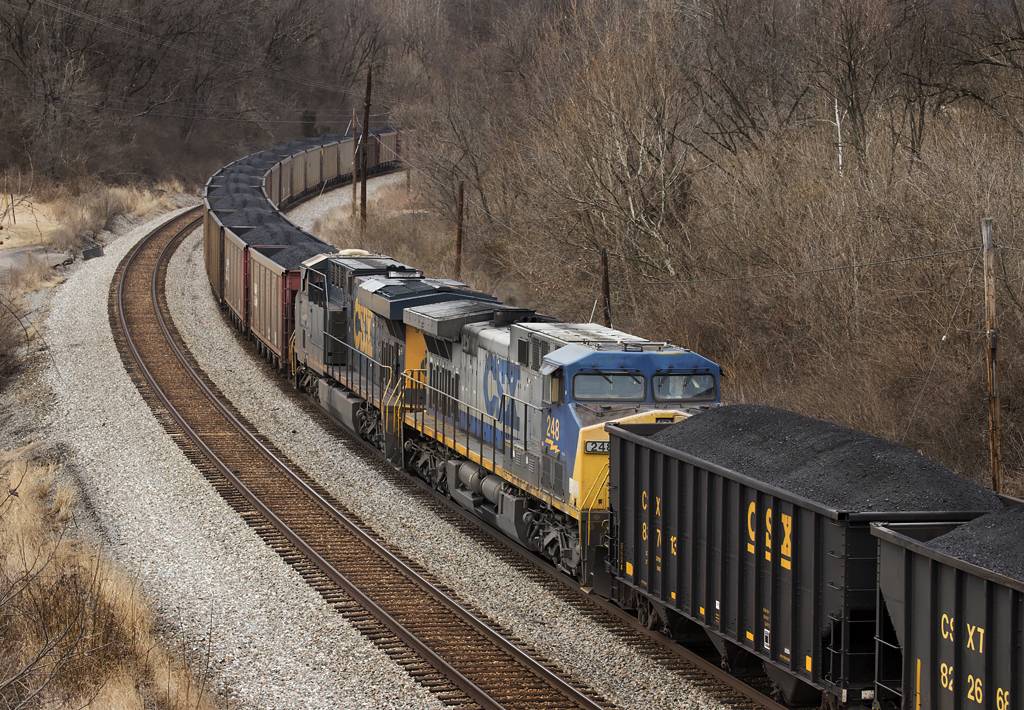
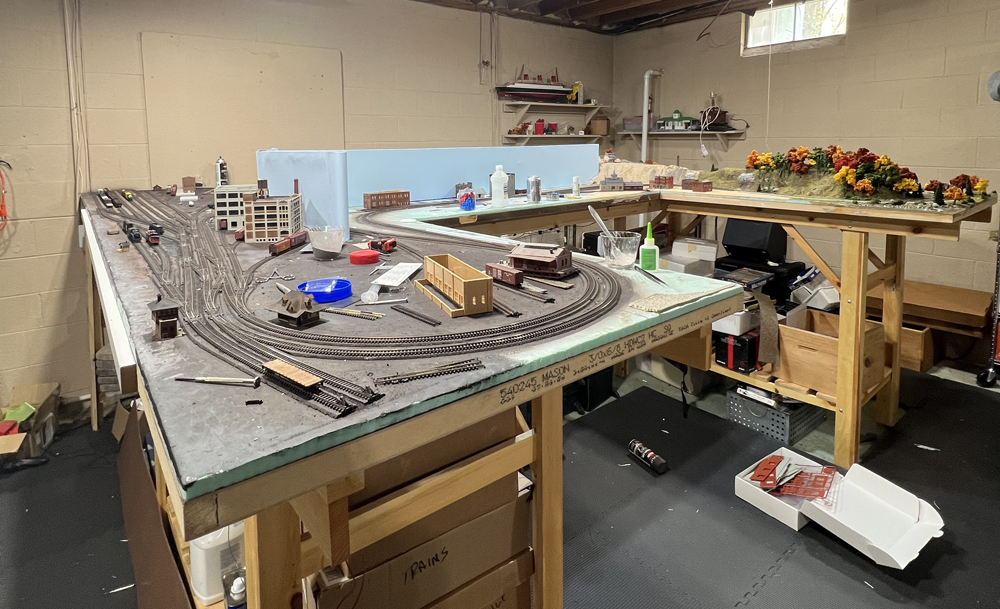
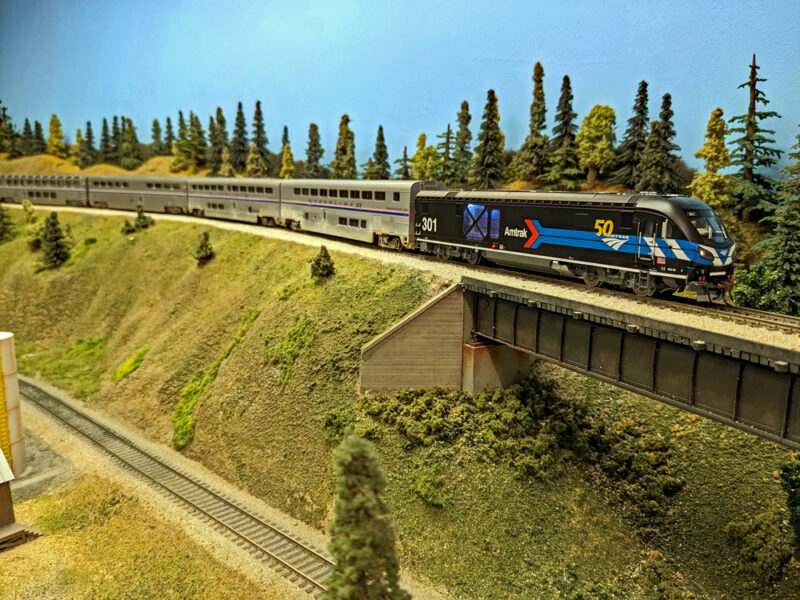
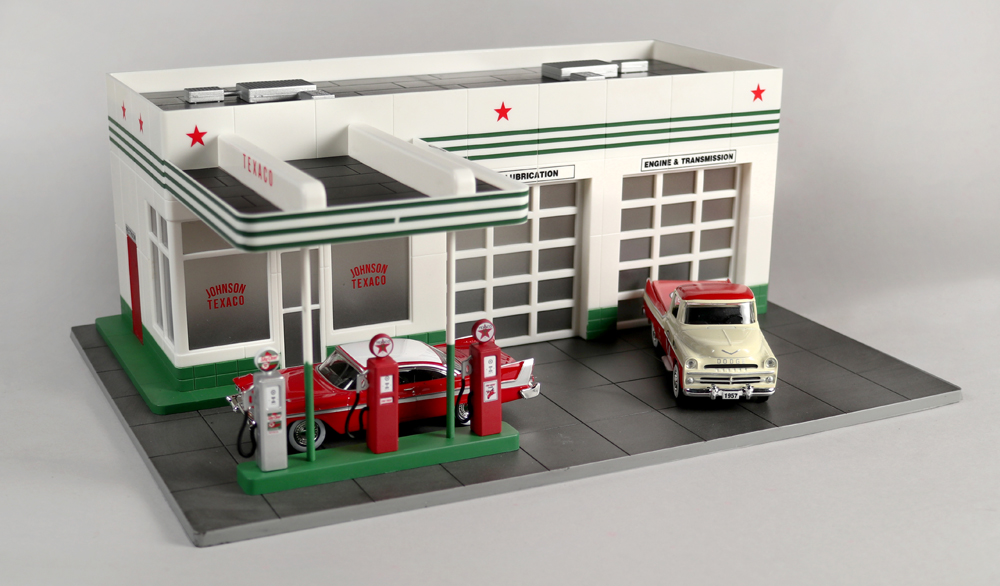




Mr. Sefton would be happy to see his collection displayed and operated in a world-class permanent exhibit!